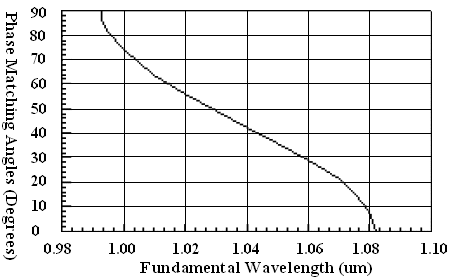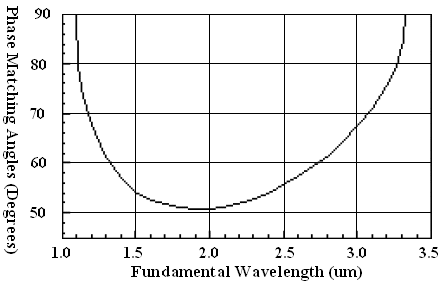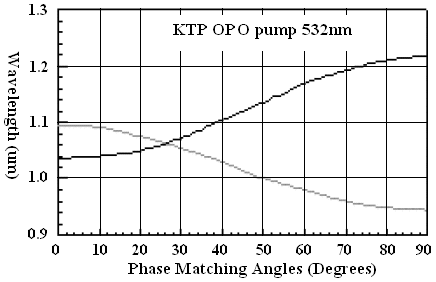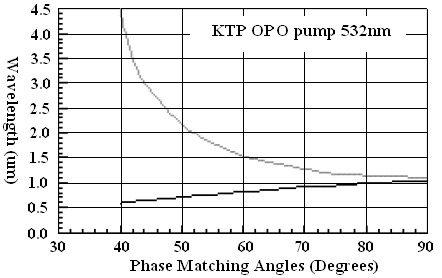|
KTP is a nonlinear optical (NLO) material which is known for its high NLO coefficient, high electro-optical coefficient, wide transparency range, small walk off angle, good chemical and mechanical properties, and a moderate optical damage threshold. These properties make KTP very attractive for different nonlinear optical applications.
Applications:
- Frequency Doubling (SHG) of Nd-doped Lasers for Green/Red Output
- Frequency Mixing of Nd Laser and Diode Laser for Blue Output
- Parametric Sources (OPG, OPA and OPO) for 0.6mm-4.5mm Tunable Output
- E-O Modulators and Optical Switches
Phase Matching Angles:
Figure 1 & 2 show type II SHG phase matching angles vs. fundamental wavelengths in both XY and XZ planes. In XY plane the slope ∂(Δk)/∂θ is small, which ensures a large acceptance angle and a small walk off. In XZ plane the slope ∂(Δk)/∂λ is almost zero around the wavelength 2.0um, which ensures a large spectral acceptance. These two techniques are known as non-critical phase matching (NCPM).
| |

|
| |
Figure 1: KTP type II phase-matching angles vs. wavelengths in XY plane
|
| |

|
| |
Figure 2: KTP type II phase-matching angles vs. wavelengths in XZ plane
|
| |

|
| |
Figure 3: KTP OPO tuning curve in XY plane
|
| |

|
| |
Figure 4: KTP OPO tuning curve in XZ plane
|
Figure 3 & 4 show OPO tuning curve in both XY and XZ planes with a pump wavelength 532nm. As an efficient OPO crystal, KTP generates tunable parametric sources from visible (0.6um) to mid-IR (4.5um). Due to the development of NCPM, KTP OPO/OPA pumped by a tunable laser such as Ti:Sapphire could generates new wavelengths from 1.04um to 1.45um at a fixed KTP orientation.
| |
Crystal Structure |
Orthorhombic
|
|
| |
lattice constant (Å) |
a = 6.404, b = 10.616, c = 12.814
|
|
| |
Melting Point (°C) |
1172
|
|
| |
Mohs Hardness |
≈ 5
|
|
| |
Density (g/cm^3) |
3.02
|
|
| |
Absorption Coefficient (/cm) |
α<0.001 at 1064nm & 532nm
|
| |
Hygroscopic Susceptibility |
No
|
|
| |
Relative Dielectric Constant |
εeff = 13 |
| |
Linear Coefficient of Thermal Expansion (100°C) ( /K)
|
a1: 8.7X10-6
a2: 10.5X10-6
a3: -0.2X10-6
|
|
| |
Transmission Range (nm) |
350~4500
|
|
| |
Damage Threshold (MW/cm2)
|
10 at 1064nm |
|
| |
Constant of Dispersion (dn/dT) (/°C) |
dnx/dT = 1.1X10-5
dny/dT = 1.3X10-5
dnz/dT = 1.6X10-5
|
|
| |
Refractive Indices |
nx = 1.7377, ny = 1.7453, nz = 1.8297 at 1064 nm
nx = 1.7780, ny = 1.7886, nz = 1.8887 at 532 nm |
|
| |
Sellmeier Equations (λ in um)
|
nx2 = 3.0065+0.03901/(λ2-0.04251)-0.01327×λ2
ny2 = 3.0333+0.04154/(λ2-0.04547)-0.01408×λ2
nz2 = 3.3134+0.05694/(λ2-0.05658)-0.01682×λ2 |
|
| |
Nonlinear Optical Coefficients (pm/V)
(at 1064nm)
|
d31=2.54, d32=4.35, d33=16.9, d24=3.64, d15=1.91
deff(II)=(d24-d15)sin(2Φ)sin(2Θ)-(d15sin2(Φ)+d24cos2(Φ)sin(θ) |
|
| |
Table 1: KTP Properties
|
|
|






